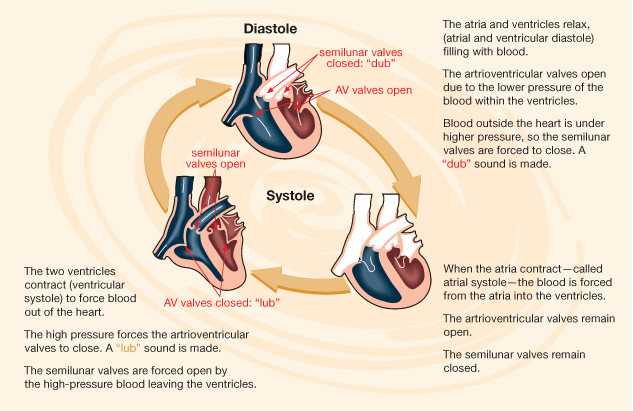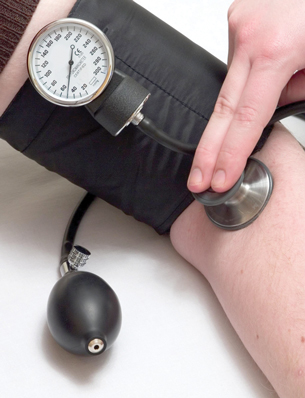Module 8 Intro
1. Module 8 Intro
1.11. Page 2
Module 8—Circulation, Immunity, and Excretion
 Explore
Explore
 Watch and Listen
Watch and Listen
As a review, watch this animation about the role of pressure in the beating heart.
 Read
Read
Blood Pressure
arterial pressure: the pressure blood exerts on artery walls
sphygmomanometer: a device used to measure blood pressure
diastole: the relaxation of the heart
systole: contraction of the heart
stethoscope: an acoustic medical device designed to listen to internal sounds of the human body
Have you ever been in a drugstore and decided to try sticking an arm in the blood-pressure machine by the pharmacy? A person of average height and weight typically gets a reading close to 120/80. What do these numbers mean? How can these numbers be a measure of your health?
Blood pressure refers to the force exerted by circulating blood on the walls of blood vessels. It, along with your pulse, make up the vital signs. The pressure of the circulating blood decreases as blood moves through arteries, veins, and capillaries; the term blood pressure generally refers to arterial pressure. Using a blood-pressure cuff, or sphygmomanometer, the pressure in an artery of your arm is measured.
Blood pressure is composed of two measurements: diastole and systole. Systolic pressure is the measurement of peak pressure in an artery at the beginning of the cardiac cycle or during ventricular contraction. Diastolic pressure is the measurement of the lowest pressure during the resting phase of the cardiac cycle or during ventricular relaxation. A blood-pressure reading is given by the ratio of systole over diastole.


© Lloyd Paulson/shutterstock
How do doctors know your blood pressure? If you can recall a visit to the doctor where you have had your blood pressure taken, a cuff is normally fastened firmly around your upper right arm at roughly the same height as your heart. You are seated with your arm supported by the doctor. The cuff is inflated by pumping a small rubber bulb until the artery in your arm is completely blocked. Listening with a stethoscope to the artery at your elbow, your doctor slowly releases the pressure in the cuff. As the pressure in the cuffs falls, a "whooshing" or pounding sound is heard to indicate that the blood flow has started again in the artery. The pressure at which the whoosing sound began is noted by your doctor.
An older method, which is still used today, has the cuff attached to a measuring unit on the wall and the doctor reads the height (mm) of mercury and records this number as the systolic pressure. Newer cuffs have a pressure gauge built in or are digital. The cuff pressure is further released until the whooshing sound can no longer be heard, and this is recorded as diastolic blood pressure.
What do the blood-pressure readings mean?
High Blood Pressure Range
Systolic pressure (mm Hg) |
Diastolic pressure (mm Hg) |
Stages of High Blood Pressure |
210 |
120 |
Stage 4 |
180 |
110 |
Stage 3 |
160 |
100 |
Stage 2 |
140 |
90 |
Stage 1 |
Average Blood Pressure Range
Systolic pressure (mm Hg) |
Diastolic pressure (mm Hg) |
Pressure Range |
130 |
85 |
High Average Blood Pressure |
120 |
80 |
Average Blood Pressure |
110 |
75 |
Low Average Blood Pressure |
Low Blood Pressure Range
Systolic pressure (mm Hg) |
Diastolic pressure (mm Hg) |
Pressure Range |
90 |
60 |
Borderline Low Blood Pressure |
60 |
40 |
Too Low Blood Pressure |
50 |
33 |
Dangerously Low Blood Pressure |
An average reading means that, in terms of your circulatory system, you are in relatively good circulatory system health. High or low blood pressures can indicate that some system in your body, possibly the circulatory system, is impaired and unable to maintain homeostasis. In the following activity you will explore factors that cause high blood pressure known as hypertension.